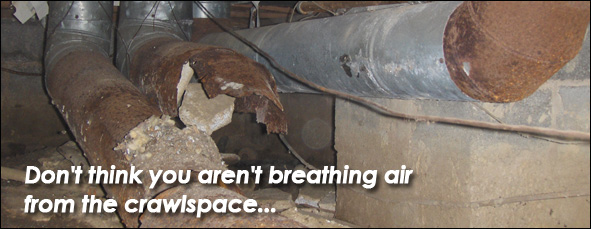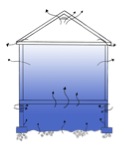
Sealing your home’s crawlspace improves indoor air quality!
The remedy to indoor air quality problems should start in your crawlspace. A crawlspace is one of the most important areas of the building, but it is often the most neglected area. Although it is not typically considered as part of the home, it has a profound impact on the air quality in the living space of the home.
 As the air warms in the home, it start to move upward. As the air escapes upward, replacement air is brought in from below the living space. This is called the “Stack Effect”. This “replacement” air comes from the crawlspace by entering the living area through the ductwork, gaps in the flooring, through and around holes in the floor from the wiring, conduit, and plumbing. If there are air quality problems in the crawlspace, it is going to effect the air quality in the living space. In fact, Up to 40% of the air on the first floor in a home originates from the crawl space.
As the air warms in the home, it start to move upward. As the air escapes upward, replacement air is brought in from below the living space. This is called the “Stack Effect”. This “replacement” air comes from the crawlspace by entering the living area through the ductwork, gaps in the flooring, through and around holes in the floor from the wiring, conduit, and plumbing. If there are air quality problems in the crawlspace, it is going to effect the air quality in the living space. In fact, Up to 40% of the air on the first floor in a home originates from the crawl space.
The Problem: Moisture
Crawlspaces are notorious for having several entry points of moisture. Many crawlspaces develop standing water problemsdue to poor grading, overflowing gutters, downspout problems, and high water tables. While flooding is a problem, most of the moisture in a crawlspace enters as water vapor, or moisture in the air. The moisture in the outdoor air will enter through the vents, band board, and holes in the framing and foundation. Venting the crawlspace brings in outdoor air into the crawlspace which will cause condensation, mold growth, and higher heating bills.
Typical Moisture Related Air Quality Problems: Mold, Dust Mites, and Musty Odors
Mold is present in every home and the outdoors, but without moisture, it cannot grow to harmful levels. Your crawlspace is by far the largest source of water vapor in your home. Mold will grow on any of the organic materials in a crawlspace, mainly the wood floor framing. Mold reproduces by forming spores (like tiny seeds), and disseminating these spores into the air – a common means of exposure for people.
All year long, mold releases spores into the air of your crawlspace. The mold doesn’t just stop there. It travels into the living space. Crawlspace mold spores can enter your home through open cavities in the sub-floor for the plumbing and electrical wiring, register vents, inside accesses, and especially the heating and air conditioning system.
Exposure to damp, moldy environments may cause several health effects, or none at all. Some people are sensitive to molds and some are not. For those that are sensitive, molds can cause nasal stuffiness, throat irritation, coughing or wheezing, eye irritation, or, in some cases, skin irritation. People with mold allergies may have more severe reactions. Immune-compromised people and people with chronic lung illnesses may get serious infections in their lungs when they are exposed to mold.
Dust Mites are the most well-known and active indoor air pollutant. House dust mites feed and grow almost exclusively on the dead, shed skin cells that we shed daily by the hundreds of thousands. Dust mites count on the humidity rising from the crawlspace to live. House dust mites prefer humidity on the high side. The mites can survive below 60 % humidity, but not very well. A conditioned crawlspace with a dehumidifier can aid in the reduction of the humidity in the home that dust mites need to thrive.
Musty Odors originating from a crawlspace is a common crawlspace moisture and mold problem. A musty odor coming from the crawlspace is very unpleasant, and no matter how often you clean your home, a musty crawlspace odor makes a home seem dirty. You might not even notice a musty odor in your home if you become accustomed to the odor, but visitors in your home will definitely notice the unpleasant musty odor.
Musty odors are most often attributed to the gaseous byproduct of mold growing in your crawlspace but there can be other sources. Standing water in the crawlspace usually doesn’t result in mold growth in the water, but bacteria may grow and produce volatiles with “musty” odors. There is usually a slime or sheen on the surface of the water. After the ground floor of the crawlspace is saturated from groundwater, a musty, wet earth odor can evaporate up into the living space above.
A crawlspace drainage system or crawlspace encapsulation system will reduce the relative humidity in the crawlspace and in your home preventing mold, mildew, dust mites, and musty odors.
